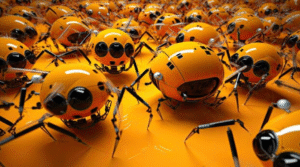
From protein folding to swarm intelligence, discover how today’s AI solves big problems by thinking small — one ‘Soant’ at a time.
In an era buzzing with AI hype, one word pops up everywhere: “solve.” Headlines promise that artificial intelligence will solve healthcare bottlenecks, solve supply chain headaches, solve climate challenges — and maybe even solve your daily to-do list.
But what does it actually mean for Artificial Intelligence to “solve” something? And where do ideas like ‘Soants’ — digital ants inspired by nature — fit into this story of machines solving the unsolvable?
Let’s break it down.
SOLVE: The Core Capability of AI
At its broadest, “solve” in AI means using smart algorithms, vast data, and immense computing power to tackle complex problems that humans struggle to handle alone — or at all.
The roots of this go back to the early days of computer science, when pioneers imagined machines not just crunching numbers but solving the kinds of puzzles that once demanded a genius mind (or many lifetimes).
Today, Artificial Intelligence is already delivering on that promise:
Solving equations & optimizations: Whether it’s calculating the most efficient delivery routes or balancing energy loads in a city, Artificial Intelligence breaks down gigantic optimization puzzles in seconds.
Cracking ancient scientific problems: Google DeepMind’s AlphaFold famously solved the protein-folding challenge, predicting how proteins fold into 3D shapes — a breakthrough for medicine and biology.
Language & knowledge tasks: Artificial Intelligence can read millions of documents, answer questions, translate languages, and summarize news — all examples of machines solving language puzzles faster than any human team could.
In other words, “solve” is the heartbeat of AI: apply computation to discover answers that would otherwise be hidden in mountains of data or locked behind mind-bending math.
SOLVE: What It Means in Machine Learning
Zoom in to the nuts and bolts, and “solve” takes on a more technical meaning in machine learning. Here, “solving” often means training a model — finding the best combination of parameters that makes an Artificial Intelligence system accurate and useful.
Picture this:
A neural network learns to recognize handwritten numbers.
Engineers “solve” for the network’s weights and biases so it can spot a sloppy ‘5’ or ‘2’ with near-perfect accuracy.
The same logic trains self-driving cars to detect pedestrians or your phone’s voice assistant to understand your accent.
The process is basically one massive math puzzle: minimize error, maximize performance — solve for the best possible result.
SOLVE: The AI Promise in Business
In the real world, “solve” is also a selling point. Tech companies pitch AI as a way to solve messy, expensive business problems:
Forecasting demand: Retailers use Artificial Intelligence to solve inventory headaches by predicting what people will buy — and when.
Automating repetitive work: Banks and insurers deploy Artificial Intelligence bots to “solve” tedious tasks like data entry and compliance checks.
Detecting fraud: Algorithms scan millions of transactions to solve the mystery of which ones are fake.
Sometimes “solve” even becomes a product name — like IBM’s Watson Solve, marketed for industrial operations and predictive maintenance. The message? Give the machines the problem — let them solve it.
Tiny Agents, Big Solutions: Meet the Soants
So what about ‘Soants’ — those software ants inspired by nature?
While not an official term in every textbook, Soants is a catchy way to describe a powerful idea: using swarm intelligence in Artificial Intelligence. Just like real ants, these tiny digital “agents” work together to find solutions to big problems — often without any central leader.
How does it work?
In nature, ants collectively find the shortest route to food by laying down pheromone trails. If one path works well, more ants follow it, reinforcing the best solution. Computer scientists mimic this behavior in what’s called Ant Colony Optimization (ACO) — a family of algorithms that tackle huge puzzles like:
Routing delivery trucks more efficiently.
Scheduling planes, trains, or ships to reduce delays.
Managing warehouse robots to pick, pack, and ship without collisions or bottlenecks.
Coordinating fleets of drones for search and rescue, agriculture, or surveillance.
In these digital “colonies,” each Soant is simple on its own — but together, they self-organize, adapt, and “solve” problems that traditional brute-force computing would choke on.
Why Does This Matter?
The magic of Soants is that they show how decentralized intelligence — lots of small agents doing simple things — can add up to solving truly massive tasks.
The same principle appears in many places today:
A self-driving car combines specialized agents: one for lane detection, another for object recognition, another for route planning.
A smart factory might deploy digital Soants that handle micro-decisions — adjusting schedules, avoiding breakdowns, re-routing tasks in real-time.
The big dream? More resilient, flexible Artificial Intelligence systems that don’t depend on one all-knowing brain — but on thousands (or millions) of tiny brains solving together.
Key Takeaway: The AI Solvers are Here
Whether it’s a towering neural network or a humble swarm of digital ants, Artificial Intelligence is about solving things: the big, the hidden, the messy, the tedious.
What was once unsolvable — protein structures, global supply chains, 24/7 customer service — is now within reach. And as we design smarter agents, more specialized bots, and inspired-by-nature swarms, the frontier keeps expanding.
So next time you hear a company say “We solve with AI,” remember: they might just mean an army of tiny Soants is hard at work behind the scenes — quietly finding paths we never knew existed.
You might enjoy listening to AI World Deep Dive Podcast: